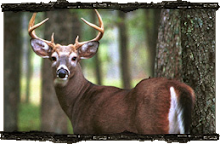
We have to live more on the edge.
A contributory factor in Western Maine's declining wildlife, is the LOSS OF EDGE. We are gradually losing our Rangeley area fields. Laws passed in the 80's discourage clear cuts by logging companies. A clear cut helps to establish new saplings and shrubs, creating forage for wildlife, including song birds. Fields are turning into forests, and well-meaning land owners are letting their property's woods mature without management. Only a small percentage of wildlife thrives in a mature forest.
Along the edges of fields grow small trees and shrubs that create "soft mast", berries, moutain ash, apple choke cherries and etc. Beech trees and Oak produce hard mast, which are picked by wildlife from the ground. Grouse, deer, bear and turkeys all compete for mast. Buds and catkins of trees and shrubs are eaten later in the fall.
Mast-producing trees and schrubs are intolerant of shade, and need sunlight. Poplar, or big-toothed aspen saplings, a popular winter food source will not flourish if shaded by mature poplar. Most wildlife need a succession of young forest to provide food sources.
The best thing a landowner can do is to identify any schrub or tree producing mast. Much of these shrubs may be on the edge of your lawn You can remove any competing tree or schrub which causes shade. Fertilizing any fruit tree can greatly enhance fruit production. There are many wild apple trees being choked out by competing forest. Rangeley once had abudant apple orchards.
You can also take a chainsaw and create small clearings in your woods. Create a new clearing every year. A chainsaw is a deer's best friend! You can also buy some "Rangeley Seed Mix" available at the River's Edge Tackle Shop and plant it on your septic tank, trails, logging roads or throw in your ditches.
Remember, its good to live on the edge.


No comments:
Post a Comment